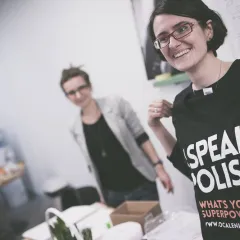In Poland, or more specifically Warsaw, there are ten thousand Tibetans. Some stay, others go further West, and more visit their families. The very first Tibetans came to Poland, because of Dalai Lama’s visit in 1993. They were students who had been awarded with Medical School scholarships and Tibetan teachers at the University of Warsaw. More came to Poland along with their Polish wives. They prefer to avoid official events, gather together among themselves and celebrate Tibetan feasts and traditions. Over the last few years, places have emerged, where we can meet Tibetans living in Warsaw and get to know their culture directly. These are: Tibet House Acala in Mokotowo and Tibetan Shop (in the malls next to Zielna Street and Metro station ‘Świetokrzyska’). Underneath we present an interview with dr. Thrupten Kunga, the owner of Tibetan Shop and a Tibetan lecturer at the University of Warsaw:
Continent Warsaw: How many Tibetans live in Warsaw and what do they do?
dr Thupten Kunga: Let me count- eighteen. I don’t know three of them, the rest I know more or less. I came here in 1994 and was one of the first Tibetans in Warsaw. I was offered a job at the University; the rest do many different things- three are monks, four are students, some of them work, but because they don’t know much Polish, they find it difficult to get a job. At the beginning of 2000, a few Tibetans came to Poland after their marriage to Polish citizens. It’s very difficult to get here. Some people have residence cards, some have visas and the people who are married to Polish people, have Polish nationality. It took me three years to get one. In other cases, one has to cut through the red tape.
CW: Is Polish difficult? How many Tibetans can speak Polish?
dr TK:: Polish is a very difficult language and it’s hard to learn it. I can speak a little Polish, because I have been living here for thirteen years. People who came here two or three years ago understand a lot, but can hardly speak.
CW: Why did you choose Warsaw? Do you know why other Tibetans chose this city?
dr TK: After graduation I started my work at the University of Warsaw. I like this country and this city. The main reason why Tibetans live outside Tibet is the situation in their country, which is occupied by the Chinese. I got a job, some others got married and some of them wanted to study and were given a chance.
CW: Have you got any particular, favourite place in Warsaw?
dr TK: Of course there are a lot of places where you can spend some time with friends, but I don’t have my favourite.
CW: Are there places connected with Tibet?
dr TK: There are Buddhist centers where one can practice Buddhism. There is Tibet House ‘Acala’ which is a very interesting place for meetings, meditations and a traditional Tibetan medical center. In 2003 I opened a Tibetan Shop. It has been visited by many people who are interested in oriental articles and Tibet. There are things concerned with religion; adornments, clothes, jewelry and books.
CW: What do you think about citizens? What is their attitude towards foreigners?
dr TK: I don’t have any unpleasant experiences. Mutual relations depend on both sides. In my opinion people living in Warsaw are friendly and open.
CW: Do you organize ceremonies to celebrate Tibetan feasts?
dr TK: There are eighteen of us and it’s too little to create a powerful community. We try to help one another; save our lifestyle and religion, but it’s difficult. We celebrate Tibetan New Year, Dalai Lama’s birthday and other feasts. It would be perfect to create a centre of Tibetan culture, place where one could meet, discuss and watch films. Unfortunately there’s still no such place.
CW: Thank you for your time. Hopefully we will meet in the Center of Tibetan Culture next time.
***
Warsaw is a place strongly connected with Tibetan culture. Besides the Tibetans who live here, there are vibrant Buddhism Centers. A series of lectures and video sessions about Tibetan tradition are conducted by Maciej Magura Góralski in Museum of Asia and Pacific. One can learn the Tibetan language privately and at the University of Warsaw. There is an established Helsinki Foundation for Human Rights in Warsaw, which regularly publishes reports on situation in Tibet. At the invitation of HFHR Dalai Lama visited Poland and Warsaw twice, in 1993 and in 2000, and was awarded with an Order of Smile. Every year, pickets and demonstrations are held in front of Chinese Embassy in order to highlight the Tibetan tragedy- especially on the 10th March; the anniversary of Tibetan National Uprising. In addition, The Other Space Foundation (the editor of Continent Warsaw) implements a Tibetan Program by taking educational actions and organizing campaigns in aid of Tibet.
If we are lucky enough to take part in Tibetan events, we will surely be able to get to know the elements of Tibetan culture and tradition.
The most important religious events are Puja and the Sand Mandala Ceremony. These are officiated by two monks- A Jam and Sherab, who live in Tibet House.
Puja is a Tibetan ceremony, during which holy verses and prayers are recited. Mandala reflects either one of the Buddhist ideas, or one of the deities- Bodhisattvy or Buddha. It is performed with extreme precision by using coloured seeds of sand for several days. When it’s ready, it’s destroyed as a symbol of impermanence. The sand is usually thrown into a river.
Tibetan cuisine is also characteristic; the most essential dishes are momo dumplings, tsampa or salted tea with butter. There is beer called Tsang, but to try its real taste, one has to visit Tibet, India or Nepal. Tsampa- roasted barley flower is unavailable in Warsaw, while salted tea with butter doesn’t meet European drinking habits.
If we are very lucky, we can watch live a Tibetan performance. Some years ago, they set up an informal group ‘Snow Lions’. Because they like dance and entertainment by nature, from time to time in Warsaw one can listen to traditional Tibetan songs accompanied by Dra Nian’s guitar. A traditional Tibetan costume is the Zhuba. When worn by men, this robe is fastened under one arm only and tightened with a belt; worn by women, it is reminiscent of a straight dress. One of the most important Tibetan traditions is offering the Khata- a white scarf- to those whom they wish to pay their respects, such as lama. Costumes, decorations, incenses and Tibetan jewelry are available in the shop at Zielna Street.
The most important Tibetan events, apart from the Buddhist, are:
Losar - Tibetan New Year, celebrated according to Tibetan Lunar Calendar. In Tibet, this celebration lasts for three weeks and supports Molan- The Holiday of Great Prayer. In India it lasts only three days and is accompanied by traditional performances, official celebrations, concerts and family meetings. In the West different events take place. Tibetans usually celebrate with friends. According to the Tibetan Calendar, the year 2007/2008 is 2134 (calculated from the first king of Tibet- Niatri Tsenpo) or the Year of Fire Pig on the Kalachakra calendar. The next Losar will be celebrated the day after the full moon, on the 7th February 2008.
10th March - The Anniversary of the Tibetan National Uprising (1959); this day is an International Day of Support for Tibetans. Traditionally, Dalai Lama gives a speech and the most important official Tibetan institutions- Parliament and Government In Exile- make their statements.
6th July - XIV Dalai Lama’s Birthday- celebrated as World Tibet Day. Traditionally Tibetans meet on that day to celebrate their spiritual leader’s birthday.
It is hard to talk about Tibetan tradition and culture, without taking into account its complicated situation. In 1950, Tibet was invaded by The People’s Republic of China. In 1959, an anti-Chinese revolt broke out and Dalai Lama- the greatest spiritual and political Tibetan leader- decided to live in exile. He obtained political asylum in India, where he re-established the Tibetan Government In Exile and soon Parliament, and drafted The Charter of the Tibetans In Exile. 80,000 Tibetans followed Dalai Lama. Since that time, year by year, around three thousand Tibetans cross this dangerous Himalayan border. Many of them are pilgrims who want to see Dalai Lama and to listen to his lectures once in their lifetime. Some others decide to escape the country as a result of political oppression. Many of them are Buddhist monks and nuns; also children. In Tibet, there is a political campaign against religious institutions, and the educational system is very poor, concentrated on the assimilation of Tibetans. In turn Dalai Lama exhorts to start real negotiations, which will lead to authentic autonomy of Tibet within China. The greatest numbers of refugees live in India (estimates differ from 90,000 to 150,000) then in Nepal and in Bhutan. For years, numerous Tibetan Diasporas have appeared in Europe; mainly in Switzerland, Scandinavia and in Great Britain of late, as well as The United States, Canada, and of course, in Poland. Tibet is home to around six million Tibetans.
Dr Threpten Kunga, Piotr Cykowski / November/December 2007
Translated by ate






